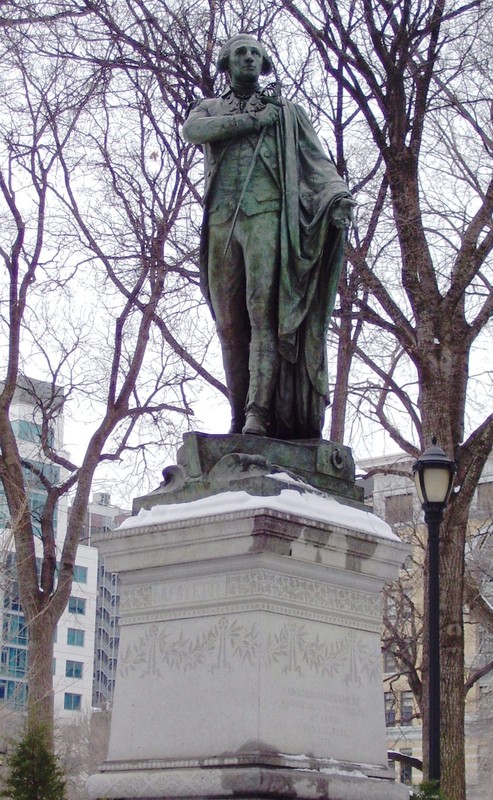Marquis de Lafayette Statue
Introduction
Text-to-speech Audio
Images
French statesman and military leader Marquis de Lafayette is best remembered for his role in the American Revolutionary War. A fan of America’s cause, he helped the colonists by donating his experienced military leadership. Lafayette quickly became a right-hand-man to General George Washington, who appointed him Major General in the Continental Army in 1777. In 1778, Lafayette returned home to France after a formal agreement of the France/United States alliance against Great Britain. Once in France, he often spoke out for the allotment of increased military and financial aid for the American Colonies. In 1780, Marquis de Lafayette returned to America and served in the Virginia campaign, which forced the surrender of Lord Charles Cornwallis in 1781.

This statue made of bronze honors Marquis de Lafayette. He was a French aristocrat who became an Army General in the United States and fought on behalf of American rebels during the American Revolutionary War. The statue was casted in 1873 by French sculptor Frédéric Auguste Bartholdi, and was dedicated in 1876. The statue can be found in Union Square Park in Manhattan, New York. It is located on Park Avenue South and 16th street and is always free and open to the public. The piece is a sign of appreciation from the French government for help that the state of New York gave to Paris during the Franco-Prussian War. It is inscripted with the words, “in remembrance of sympathy in times of trial.”

Backstory and Context
Text-to-speech Audio
French statesman and military leader Marquis de Lafayette is best remembered for his role in the American Revolutionary War. A supporter of America’s cause during a time when France saw the war as an opportunity to acquire British islands in the Caribbean, Lafayette was sent to assist the colonists. Owing to his exprience, Lafayette quickly became a right-hand-man to General George Washington, and was appointed a Major General in the Continental Army in 1777. In 1778, Lafayette returned home to France after a formal agreement of the France/United States alliance against Great Britain. Once in France, he often spoke out for the allotment of increased military and financial aid for the American Colonies. In 1780, Marquis de Lafayette returned to America and served in the Virginia campaign, which forced the surrender of Lord Charles Cornwallis in 1781.
In 1789, Lafayette took a leading role in the French Revolution. He became a member of the National Assembly, and wrote the Declaration of the Rights of Man, a bill of rights based on the Virginia Declaration of Rights. He was a commander for the French National Guard and joined a political party, the Feuillants, which advocated for a constitutional monarchy. Lafayette was given leadership of a French division in 1792 in the war against Austria. He was physically beaten by radicals within his ranks known as the Jacobins, and was later imprisoned by Austrian authorities for five years.
After returning to France, and following Napoleon’s defeat at Waterloo, Lafayette served as a member of the Chamber of Deputies in 1815 and again from 1818 to 1824. He went back to the United States in 1824 and Congress gave him a gift of $200,000 and a large piece of land. Today, Marquis de Lafayette, is known as a statesman and general who was an experienced military leader and supporter of democracy and religious freedom.
The large figure was sculpted by Frédéric-Auguste Bartholdi, who also designed the Statue of Liberty, which was another gift from the French government. The granite pedestal that the sculpture of Marquis de Lafayette stands on was designed by H.W. DeStuckle and was donated by French citizens living in New York. Lafayette appears in another Bartholdi sculpture at Lafayette Square in Manhattan that shows him and General George Washington shaking hands.
Lafayette is also honored in Brooklyn’s Prospect Park with a carving by Daniel Chester French, who also designed the figure of Abraham Lincoln at the Lincoln Memorial in Washington, D.C. In 1991, the statue of Marquis de Lafayette was conserved through the Adopt-A-Monument Program, a joint program of the Municipal Art Society, Parks and the New York City Art Commission.
Sources
Union Square Park Marquis de Lafayette, NYC Parks. Accessed March 21st 2020. https://www.nycgovparks.org/parks/union-square-park/monuments/884.
The Marquis de Lafayette, US History. Invalid date. Accessed March 21st 2020. https://www.ushistory.org/valleyforge/served/lafayette.html.
Marquis de Lafayette, Biography. April 22nd 2014. Accessed March 21st 2020. https://www.biography.com/political-figure/marquis-de-lafayette.
https://www.biography.com/political-figure/marquis-de-lafayette
Wikipedia
